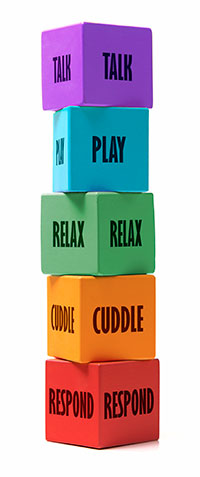The bond between you and your baby is the most important they will make and will affect the way your child grows up and sees their life. This is called 'attachment' and simply means that children need trusted adults who love them and keep them safe as they learn about the world.
It is never too early to start bonding with your baby. When they are still in the womb, babies begin to become aware of their world and can recognise adults’ voices.
New parents can even talk and sing to their 'bump' to help to start the process of bonding and attachment.

Meet the Brains
Ways to build bonds with babies
 Most of the time, bonding with your baby will come naturally and you’ll do many things that build a healthy attachment by instinct.
Most of the time, bonding with your baby will come naturally and you’ll do many things that build a healthy attachment by instinct.Five to Thrive is one simple approach which can help parents to become more aware of how their actions help to build strong bonds. It lists five things that happen every time an adult connects to a baby or young child. These are:
Respond – your child feels safest when they know you are thinking about them and their needs. This means responding if they are trying to tell you something with their actions or words.
Cuddle – touch and closeness is vital for young children to develop a physical bond. This might be skin to skin contact for babies or cuddles and hugs for older children.
Relax – children aren't born able to cope with their feelings. They learn from seeing how other people cope. When you relax you show your child how to calm down too.
Play – all children enjoy play and you are their best toy! When your child is calm and you have each other's attention, playing together helps you to bond.
Talk – talking to your child, even before they are able to talk themselves, is really important to help them learn language, learn about the world and how to form relationships with other people.

How can I use Five to Thrive?
Five to Thrive is very simple but works best when it is used as a sequence. Often in daily life these activities happen all together and very quickly – think of a small child who is exploring but who tumbles down and is upset. A parent leans down to ‘kiss it better’ reassuring the child softly who then calms down and goes back to learning about the world.
Some ideas for using the Five to Thrive activities include:
- Copying: Try copying your child’s facial expression and give them time to respond – and then make a face and see if they try to copy you. Babies’ brains are particularly wired to respond to faces and even the youngest children will try to copy motions like sticking your tongue out.
- Drawing: as your baby gets more mobile, put down some flour or talcum powder on the floor or a tray and let them use their fingers to draw with it.
- Contact games: ‘High Fives’, ‘Pat-a-Cake’, ‘This Little Piggy’ – babies and toddlers love physical contact with an adult! Try tickling your baby’s toes or palms and get them to tickle you too.
- Hugs and strokes: Give your baby lots of soft hugs to let them know you love them. If you sense your baby finds hugging too much try stroking their hair and head instead.
- Baby massage: This is great way to bond with your baby, showing your love through gentle touch and helping them to relax. You can even add in some soothing music or sing them a lullaby. There are often local baby massage classes which your health visitor could recommend, or plenty of videos and guidance online about how to get started.
- Out and about: Go out for a walk with your baby and talk about everything you see and hear together. Look at the buildings and people, stop to touch hedges, say hello to animals. If you can’t get outdoors look out of the window and talk about what you can see.
- Listen to music: Try sitting down and putting on some music with your child. Rock your baby with the music and sing along.
- Peekaboo: A fun game for babies is to hide your face behind your hands and then pop your face out again with a big beaming smile saying ‘peekaboo’. Get your child to try and copy you as they get older so you can take it in turns.
- Messy play: Babies and children love new sensations – that’s why playing with water, sand or paint is so popular at nursery. When your child is very little, start by letting them splash around in the bath and splash them back gently. As they get older you can start having games with other materials like flour, butter or play-dough. Always make sure you are on hand to prevent your baby from hurting themselves or putting things in their mouth – and it’s a good idea to play in a place that’s easy to clean!
- Sing-song: Sing along to songs and nursery rhymes for your baby. Try copying sounds, facial expressions or movements they make to help them join in.
- Reading: Telling stories and talking to your child are great ways to connect. Often the best stories are the ones parents make up themselves. But you can also find picture and interactive books even for very young children – ask your library if you are unsure what might be most suitable. Or why not take them to a free Bookbug song and rhyme session?
There are so many ways that you can interact with your baby and these are just some ideas to get you started. Dinnertime, bedtime, bath time – any time is a good time to bond with your baby.


